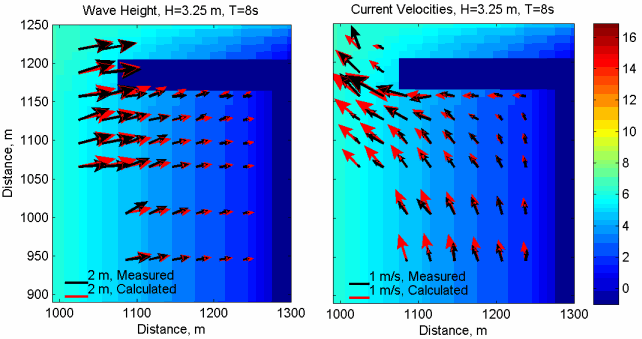SEABERGH: Difference between revisions
| (4 intermediate revisions by the same user not shown) | |||
| Line 17: | Line 17: | ||
= Results = | = Results = | ||
[[Image:Current_Height_3p25_small.gif|thumb|right| | [[Image:Current_Height_3p25_small.gif|thumb|right|700px| Figure 3. Wave heights (left) and mean currents (right) for Case 2.]] | ||
<br style="clear:both" /> | <br style="clear:both" /> | ||
Latest revision as of 21:25, 31 May 2011
Physical Model Experiment
In 2005 the USACE conducted a physical model study to collect both current and wave measurements in the vicinity of an idealized dual jetty inlet (Seabergh et al. 2005). The idealized inlet experiment was carried out in a 46-m wide by 99-m-long concrete basin with 0.6 m high walls. Figure 1 shows the facility and basin area. A 1:50 undistorted Froude model scale was used to represent the dimensions of a medium-sized Atlantic coast inlet of the United States. The equivalent full-scale (prototype) inlet dimensions were: the seaward prototype depth was 15 m at the wave generator, contours started 9.1 m from the generators with a 1/50 slope and transitioned shoreward to a steeper slope based on the equilibrium beach profile (with the scale coefficient A = 0:24). Fully reflective and fully absorbing jetties were constructed for inlet geometries studied. However, all of the tests shown here are for the fully absorbing jetties. The incident wave conditions for the test cases used here are shown in Table 1.
Table 1. General settings for the three cases Seabergh et al.(2005) used in this study
| Parameter | Value |
| Time step | 600 s |
| Simulation Duration | 4 hrs |
| Ramp Period | 3 hr |
| Steering Interval | 1 hr |
Results

References
- Seabergh, W.C., Lin, L., and Demirbilek, Z. (2005). “Laboratory study of hydrodynamics near absorbing and fully reflecting jetties,” Coastal Inlets Research Program, Technical Report ERDC/CHL-TR-05-8, Vicksburg, MS: U.S. Army Engineer Research and Development Center.